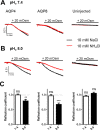Aquaporin 4 as a NH3 Channel
- PMID: 27435677
- PMCID: PMC5009286
- DOI: 10.1074/jbc.M116.740217
Aquaporin 4 as a NH3 Channel
Abstract
Ammonia is a biologically potent molecule, and the regulation of ammonia levels in the mammalian body is, therefore, strictly controlled. The molecular paths of ammonia permeation across plasma membranes remain ill-defined, but the structural similarity of water and NH3 has pointed to the aquaporins as putative NH3-permeable pores. Accordingly, a range of aquaporins from mammals, plants, fungi, and protozoans demonstrates ammonia permeability. Aquaporin 4 (AQP4) is highly expressed at perivascular glia end-feet in the mammalian brain and may, with this prominent localization at the blood-brain-interface, participate in the exchange of ammonia, which is required to sustain the glutamate-glutamine cycle. Here we observe that AQP4-expressing Xenopus oocytes display a reflection coefficient <1 for NH4Cl at pH 8.0, at which pH an increased amount of the ammonia occurs in the form of NH3 Taken together with an NH4Cl-mediated intracellular alkalization (or lesser acidification) of AQP4-expressing oocytes, these data suggest that NH3 is able to permeate the pore of AQP4. Exposure to NH4Cl increased the membrane currents to a similar extent in uninjected oocytes and in oocytes expressing AQP4, indicating that the ionic NH4 (+) did not permeate AQP4. Molecular dynamics simulations revealed partial pore permeation events of NH3 but not of NH4 (+) and a reduced energy barrier for NH3 permeation through AQP4 compared with that of a cholesterol-containing lipid bilayer, suggesting AQP4 as a favored transmembrane route for NH3 Our data propose that AQP4 belongs to the growing list of NH3-permeable water channels.
Keywords: ammonia; aquaporin 4 (AQP4); membrane protein; molecular dynamics; permeability.
© 2016 by The American Society for Biochemistry and Molecular Biology, Inc.
Figures







References
-
- Butterworth R. F. (2002) Pathophysiology of hepatic encephalopathy: a new look at ammonia. Metab. Brain Dis. 17, 221–227 - PubMed
-
- Butterworth R. F., Giguere J. F., Michaud J., Lavoie J., and Layrargues G. P. (1987) Ammonia: key factor in the pathogenesis of hepatic encephalopathy. Neurochem. Pathol. 6, 1–12 - PubMed
-
- Laursen H., and Diemer N. H. (1980) Morphometry of astrocyte and oligodendrocyte ultrastructure after portocaval anastomosis in the rat. Acta Neuropathol. 51, 65–70 - PubMed
-
- Cohn R. M., and Roth K. S. (2004) Hyperammonemia, bane of the brain. Clin. Pediatr. (Phila.) 43, 683–689 - PubMed
MeSH terms
Substances
Associated data
- Actions
LinkOut - more resources
Full Text Sources
Other Literature Sources

